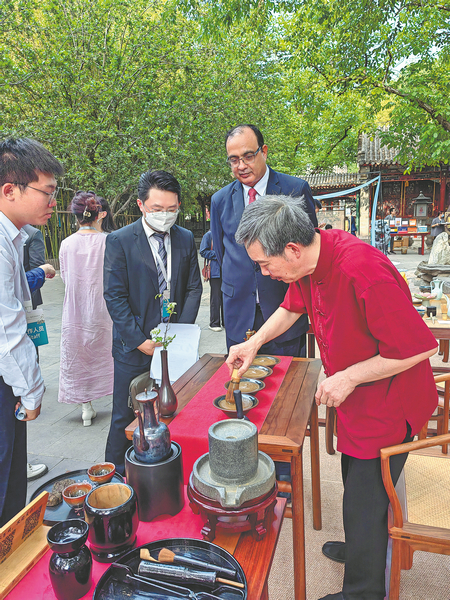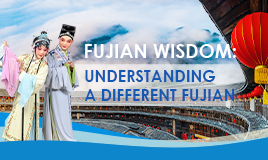Culture down to a tea

Inheritor of the chabaixi technique Zhang Zhifeng, from Fujian province, shows his expertise at the ceremony. CHINA DAILY
Domestic and international events showcase the intricate and compelling process in brewing and enjoying an exquisite taste of history, Cheng Yuezhu reports.
Accompanied by the resonant sound of traditional Chinese instruments and the chirping of birds, guests strolled into a garden nestled within the Prince Kung's Palace Museum, where tea experts from around China invited them to take a seat and relish a cup of tea.
The Beijing event, held on May 15, marked the beginning of the Tea for Harmony: Yaji Cultural Salon, hosted by the Ministry of Culture and Tourism, to celebrate China's tea culture.
Yaji, which translates to "elegant gathering", harks back to an ancient type of social event, where scholars and literati gathered to indulge in a variety of refined cultural activities such as tea tasting, guqin (traditional Chinese zither) playing and poetry composition and recital.
Part of the lifestyle of traditional Chinese literati, contemporary yaji offers a gateway for people from home and abroad to journey back in time and immerse themselves in the leisured world of scholar-officials.
A total of 75 diplomats and representatives from 41 countries and international organizations attended the event, accompanied by experts and officials from a breadth of Chinese cultural institutions, trade unions and companies.
"Tea culture has played a key role in the social development of many civilizations along the Silk Road, promoting exchanges between people and fostering mutual learning," says Shahbaz Khan, director and representative of the UNESCO Multisectoral Regional Office for East Asia, in a speech at the event.
At the salon, which delved into tea culture, a symbol of harmony, equilibrium and pursuit of inner peace, he said that he hopes to gain a deeper understanding of the value of tea, not only as a delightful beverage, but also as an embodiment of cultural heritage, identity and continuity.
Among the tea stalls at the event, that of Zhang Zhifeng, from East China's Fujian province, received considerable attention. His wares seemed closer to art than a common drink.
Guests were invited to join him and try their hand at the tea art known as chabaixi. By whisking powdered tea together with water in small quantities, a layer of foam emerges on the surface of the liquid. On this natural canvas, one can gently run a bamboo teaspoon across the surface, writing Chinese characters or painting delicate flowers, birds or landscapes, turning a cup of tea into a tasteful work of art.
For nearly 40 years, Zhang has been devoted to the preservation of this technique, the earliest mention of which is in the records of the Tang Dynasty (618-907). The art reached its prime in the Song Dynasty (960-1279).
He was first drawn to chabaixi while at university, where he majored in tea science. His introduction to the art was accidental — he stumbled upon mention of it in an ancient record. Learning that the technique was on the verge of dying out, he started researching it, and dedicated himself to restoring it.
This proved challenging, as records about chabaixi were fragmented and scattered across many different ancient poems, chronicles and paintings. He had collected several thousand relevant records by the time he made his first attempt to re-create the technique, in 2008.
Zhang says that chabaixi holds rich historical, artistic, scientific and social significance. It not only serves as a reference for ancient people's aesthetic tastes, tea-making techniques and other ways of life, but also embodies the ancient Chinese values of purity, reverence, harmony and beauty.
In the past, he has met visitors who mistook the technique for latte art, but they are not the same. This ancient technique uses clear water to create the patterns, without in any way changing the tea's essence.
"This event carries particular significance. Our focus in the past was primarily on promoting tea culture domestically, but this event is targeted worldwide," Zhang says. "It offers an authentic portrayal of Chinese culture, in all its vastness and depth."
On this year's International Tea Day, an annual celebration falling on May 21, the ministry brought together organizations from 16 provincial-level administrative regions, 19 Chinese embassies and consulates, 38 China cultural centers and five tourism offices to put on the salon in 41 countries, as well as at the headquarters of the United Nations and UNESCO.
Exhibitions, screenings, performances and demonstrations were organized, allowing visitors to gain a fuller understanding of Chinese tea culture.
Apart from the Yaji Cultural Salon, the ministry has launched another event series, titled Sharing Intangible Cultural Heritage, centered on the promotion of national preservation projects related to tea culture.
From May 19 to 22, the gathering was held in Fuzhou, capital of Fujian, co-hosted by the ministry and the provincial government.
In 2022, traditional tea processing techniques and their associated social practices in China were added to UNESCO's Representative List of the Intangible Cultural Heritage of Humanity.
The event series was first launched in December in celebration of the additions to the UNESCO list. Fifteen provinces, autonomous regions and municipalities that had contributed to the drive unveiled demonstrations to highlight important aspects of tea culture.
"This year, we further enriched the content, innovated the format, and expanded the scale of the activities," said Li Xiaosong, deputy director-general of the department of intangible cultural heritage at the ministry, at a news conference on May 16.
According to Li, more than 130 tea-related intangible cultural heritage events were organized, constituting a comprehensive display of recent achievements in the preservation and promotion of tea culture.
Li pointed to the grassroots origins of many of the cultural features on display.
"People are the owners, inheritors and beneficiaries of intangible cultural heritage. The protection of intangible cultural heritage always puts the people at the center and aims to benefit the people with its achievements," he says.
To integrate intangible cultural heritage into contemporary life, the main venue in Fuzhou hosted a wide array of activities suited to tea enthusiasts from all walks of life.
Inheritors of traditional tea culture showcased their skills. Tea-related workshops and companies displayed their products. Teenagers went on field trips to learn about the history of tea and its production, and experts shared their visions at forum discussions.
Each of the 15 regions made contributions that exemplified their unique local characteristics, putting on demonstrations of their distinctive tea-making or tea-tasting customs.
Other regions across China also hosted training sessions, lectures, exhibitions and fairs to popularize tea culture among the general public, and teenagers in particular, to celebrate this year's International Tea Day.




